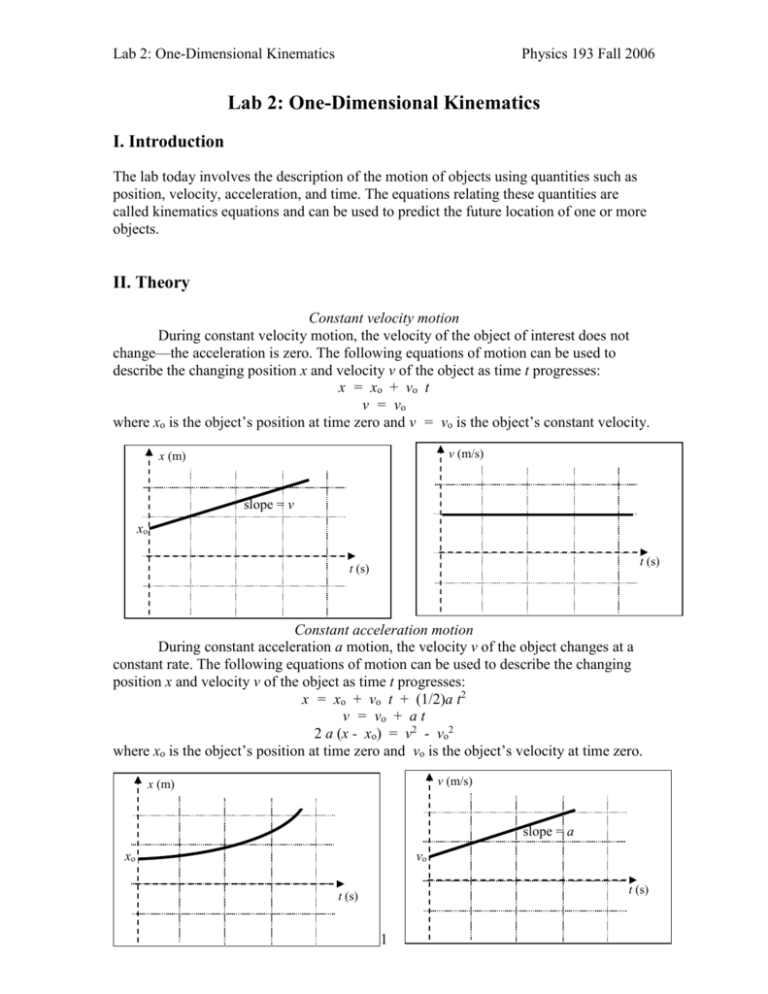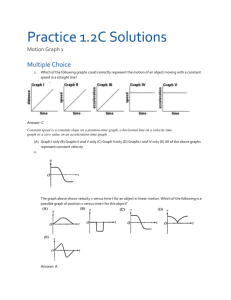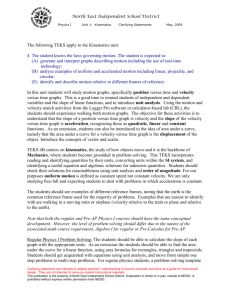Constant acceleration motion
advertisement

Lab 2: One-Dimensional Kinematics Physics 193 Fall 2006 Lab 2: One-Dimensional Kinematics I. Introduction The lab today involves the description of the motion of objects using quantities such as position, velocity, acceleration, and time. The equations relating these quantities are called kinematics equations and can be used to predict the future location of one or more objects. II. Theory Constant velocity motion During constant velocity motion, the velocity of the object of interest does not change—the acceleration is zero. The following equations of motion can be used to describe the changing position x and velocity v of the object as time t progresses: x = xo + vo t v = vo where xo is the object’s position at time zero and v = vo is the object’s constant velocity. v (m/s) x (m) slope = v xo t (s) t (s) Constant acceleration motion During constant acceleration a motion, the velocity v of the object changes at a constant rate. The following equations of motion can be used to describe the changing position x and velocity v of the object as time t progresses: x = xo + vo t + (1/2)a t2 v = vo + a t 2 a (x - xo) = v2 - vo2 where xo is the object’s position at time zero and vo is the object’s velocity at time zero. v (m/s) x (m) slope = a vo xo t (s) t (s) 1 Lab 2: One-Dimensional Kinematics Physics 193 Fall 2006 III. Experiments Using a Motion Detector to Measure Motion Read the write-up on how to use Logger Pro that is taped next to the computers. We will use a motion detector to produce position-versus-time and velocity-versus-time graphs of the motion of a dynamics cart on a track. The motion detector can record the cart’s position if farther than about 0.5 m from the detector and if closer than about 2 or 3 meters from the detector. You have to be careful that the motion detector is not measuring the position of some other object than the intended object—keep other things out of the region in front of the detector. Be sure the track is level and clean (to reduce friction). Experiment 1a—constant velocity in positive direction: Place the cart about 0.5 meters from the detector and give it a gentle push. Then release the cart so that it glides slowly away from the detector. If moving at constant velocity, the position-versus-time graph should look something like shown in (a) below and the velocity-versus-time graph should look like that shown in (b). Do the graphs look like those shown below? If not, why not? Repeat the motion, only push the cart a little harder so that it glides at a faster initial velocity. In (c) and (d) below, draw a position-versus-time graph and a velocity-versustime graph for this observed motion when starting at a faster velocity away from the detector. (a) (b) v (m/s) x (m) slope = v xo t (s) t (s) (c) (d) v (m/s) x (m) t (s) t (s) 2 Lab 2: One-Dimensional Kinematics Physics 193 Fall 2006 Note that the initial position xo on the position-versus-time graphs is the cart’s position at time zero. Note that in (a) and (c) the slopes of the position-versus-time graph (∆x/∆t) are positive since the cart is moving in the positive direction—the velocity is positive. Note that the magnitude of the slope is greater in (c) than in (a) because it is moving faster in (c) than in (a). Note that if the velocity is constant, the velocity-versus-time graphs (b) and (d) should have zero slope. For such motion, the acceleration is zero as is the slope of the velocity-versus-time graph line (a = ∆v/∆t). Is this what you observe? Explain. Finally, note that the velocity graph line has a greater value in (d) compared to (b)—a greater velocity in (d) than in (b). Experiment 1b—constant velocity in negative direction: Place the cart about 2.0 meters from the detector and move it slowly toward the detector at constant velocity. The position-versus-time graph should look something like shown in (a) below and the velocity-versus-time graph should like something like that shown in (b). Repeat the motion only move it at a faster initial velocity. In (c) and (d) below, draw a positionversus-time graph and the velocity-versus-time graph for this observed motion at a faster initial velocity toward the detector. (a) (b) v (m/s) x (m) xo slope = v t (s) t (s) (c) (d) v (m/s) x (m) t (s) t (s) 3 Lab 2: One-Dimensional Kinematics Physics 193 Fall 2006 Note that the initial position xo on the position-versus-time graph is the cart’s position at time zero. Note that in (a) and (c) the slopes of the position-versus-time graph (∆x/∆t) are negative since the cart is moving in the negative direction—the velocity is negative. Note that the magnitude of the negative slope is greater in (c) than in (a) because it is moving faster in (c) than in (a). Note that if the velocity is constant, the velocity-versus-time graphs (b) and (d) should have zero slope. For such motion, the acceleration is zero as is the slope of the velocity-versus-time graph line (a = ∆v/∆t). Is this what you observe? Explain. Finally, note that the velocity graph line has a greater negative value in (d) compared to (b)—a greater speed in the negative direction in (d) than in (b). Experiment 1c Calculating the slope: Place the cart about 2.0 m from the detector and give it a medium push so that it glides toward the detector. It should move at approximately constant velocity if the friction is small. If it doesn’t, you will have to take average values in some of the following calculations. For constant velocity motion, the position-versus-time graph should be a straight tilted line whose slope is the velocity of the cart. If the line is not straight, pretend that it is straight and calculate the average slope if it was straight. It should be negative for this experiment. To do this: Take a point (x1, t1) near the beginning of the graph line and a second point (x2, t2) near the end. Record the values of these points. Use these two points to calculate the average slope of the graph line, which equals the average velocity of the cart: x x1 Slope of position-versus-time graph line = average velocity = v = 2 t 2 t1 Then look at the velocity-versus-time graph. If friction was causing the cart’s speed to decrease, compare the velocity about half way between t1and t2 on that graph to the value calculated using the slope of the position-versus-time graph. Use the weakest link rule to see if the calculated and experimental values of the average velocity are the same within the uncertainty of the equipment. Remove the track. In the next experiments you will be the object whose motion is recorded. One person in your lab group will walk in front of the motion detector and the other person in the group will turn the motion detector on and off. Experiment 2 Recording your own motion: The person walking should try the following experiments. Constant negative velocity: Start about 3 m from the motion detector and walk at constant speed toward the detector. Have your lab partner turn the motion detector on when you are about 2 m from the detector. Note the shape of the position-versus-time and the velocity-versus-time graphs. Are they like the graphs in Experiment 1a? Constant negative velocity: Repeat the previous experiment only this time walk at a faster constant speed but toward the detector. Is the negative slope greater on the position-versus-time graph? 4 Lab 2: One-Dimensional Kinematics Physics 193 Fall 2006 Constant positive velocity: Repeat the previous two experiments only this time start about 0.4 m from the motion detector and walk at constant speed away from the detector—the first time slow and then again only faster. Have your lab partner turn the motion detector on when about 0.5 m from the detector. Note the shape of the position-versus-time and the velocity-versus-time graphs. Are they like the graphs in Experiment 1b? Positive acceleration in the positive direction: Next, start at rest 0.5 m from the detector and walk at increasing speed away from the detector. This is accelerated motion—your velocity is changing. Try to produce a velocity-versus-time graph as shown on the right graph below. The position-versus-time graph should look approximately as shown on the left graph below. Repeat the walking only this time try to move with greater acceleration motion—the velocity-versus-time graph should have a greater slope. v (m/s) x (m) slope = a xo vo t (s) t (s) Negative acceleration in the positive direction: Next, start moving fast about 0.3 m from the detector and walk at decreasing speed away from the detector. Watch the velocity-versus-time graph as you walk and try to produce constant acceleration motion such as shown on the right graph below. v (m/s) x (m) slope = a xo vo t (s) t (s) 5 Lab 2: One-Dimensional Kinematics Physics 193 Fall 2006 Negative acceleration in the negative direction: Move toward the detector from about 3 m away. Start at rest and move faster and faster. Try to reproduce the constant acceleration velocity-versus-time graph shown below on the right. v (m/s) x (m) xo vo t (s) t (s) slope = a Positive acceleration in the negative direction: Start recording the motion while moving toward the detector from about 3 m away. Move slower and slower. Try to reproduce the constant acceleration velocity-versus-time graph shown below on the right. v (m/s) x (m) xo vo t (s) t (s) slope = a We can summarize the velocity-versus-time graphs with a small number of rules: If moving in the positive direction, the v-vs-t graph line is in the positive region (above the time axis) and if moving in the negative direction, the graph line is in the negative region (below the horizontal time axis). For constant velocity motion, the velocity-versus-time graph is constant—horizontal. If the speed is increasing, the velocity-versus-time graph line is moving away from the time axis as time progresses—the magnitude of the velocity is getting bigger, either more positive or more negative. If the speed is decreasing, the velocity-versus-time graph line is moving toward the time axis as time progresses—the magnitude of the velocity is getting smaller, either less positive or less negative. The sign of the acceleration depends on the slope of the velocity-versus-time graph line and not on whether the object is speeding up or slowing down. 6 Lab 2: One-Dimensional Kinematics Physics 193 Fall 2006 Experiment 3: Your next task is to move in such a way that your motion matches the graphs in some special files. Read the instructions about which files to open, and how to match graphs. Then open one of the files and try to reproduce the motion. If there are dramatic differences, repeat the process until you have a reasonable qualitative match. Be sure that both members of your lab group get to do all parts of the lab. Equipment for Experiment 4: Dynamics track, motion detector, two battery-operated cars, meter stick, stopwatch, sugar packets. Experiment 4: In this experiment we will apply kinematics equations to predict where two battery-powered cars moving toward each other from the ends of the dynamics track will meet. Here is what you are to do. a) Determining the speeds of the two cars: Get one of the cars to move on the dynamics track and measure its constant speed using a motion detector. Repeat the process for the second car. b) Write equations of motion for each car: The goal here is to predict when the cars will meet and where the cars will meet if they start about 2.0 m apart and are moving toward each other. To do this, you first need to write equations of motion for each car. Car 1: Place it at x1o = 0 (or some other convenient value near the beginning end of the track). Its initial velocity v1o, which is its constant velocity for the whole trip, will be positive and have the magnitude determined in part (a). You can insert these values in the equation for car 1: x1 = x1o + v1o t With the values inserted, this is now an equation of motion for car 1 that indicates its position x1 at any time t in the future. Car 2: Place it at x2o = 2.0 m (or some other convenient value at that end of the track). Its initial velocity v2o will be negative and has the magnitude of the constant velocity determined in part (a). You can insert these values in the equation for car 2: x2 = x2o + v2o t With the values inserted, this is now an equation of motion for car 2 that indicates its position x2 at any time t in the future. c) Calculate the time when the cars are at the same position: The cars will start moving toward each other at the same time, car 1 from x = 0 and car 2 from x = 2.0 m. The cars will be at the same position at some unknown later time when x1 = x2. Set the equations of motion equal to each other and determine the time when the two cars are at the same position. 7 Lab 2: One-Dimensional Kinematics Physics 193 Fall 2006 d) Calculate the position of each car at that time: Go back to the equations of motion and insert the time determined in (c) into the equation of motion for each car. You will find the location of that car at the time determined in (c). You should get the same position for each car. e) Estimate the experimental uncertainty in these predicted values: List the sources of experimental uncertainty and the uncertainty in each quantity involved in your calculations. Then calculate the percent uncertainty of each of these quantities. Finally, use the weakest link rule to estimate quantitatively the uncertainty in your final predicted meeting time and meeting position. f) Try the experiment: Do the real experiment and observe closely when and where the cars meet. You will have to be careful to start the cars at the same time. Record the meeting time and the meeting position. IV. Homework: Work the problems below before lab next week. Turn them in at the beginning of Lab 3. They are a review of the ideas used in Lab 2. 1. Determine the acceleration of a Cadillac whose velocity changes from –10 m/s to –20 m/s in 4.0 s. (b) Determine the car's acceleration if its velocity changes from –20 m/s to –18 m/s in 2.0 s. (c) Explain why the sign of the acceleration is different in (a) and (b). 2. Two objects move so that their positions with respect to the Earth depend on time as follows: x1 = 10 m – (4 m/s) t; x2 = - 12 m + (6 m/s) t. Represent their motions graphically (position-versus-time and velocity-versus-time). Use the graphical representations to find where and when they will meet. 8






